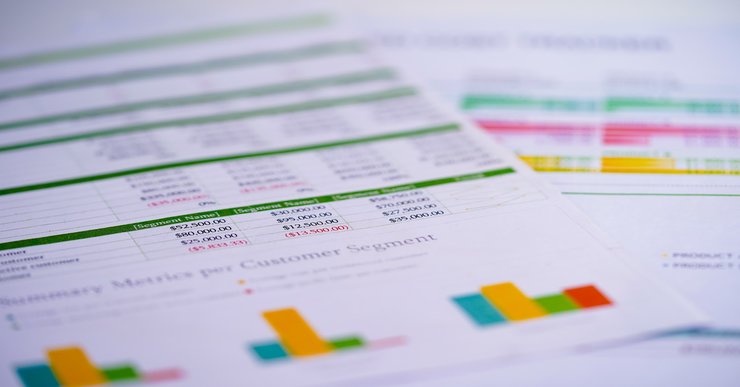An applicant’s bank statement gives a periodic view of all the transactions undertaken by them including deposits, withdrawals, transfers, debit card payments, interest earned, bank service fees, as well as the other instalments they are paying. Lenders analyze the frequency of the transaction to estimate an applicant’s ability to repay the loan in time. Analyzing bank statements can help surface critical financial information when assessing a loan applicant’s eligibility for a business loan he may have applied for.
How to Ease the Lending Process Through Bank Statement Analysis?

Lending can be a risky proposition, and thus lenders must weigh the pros and cons of every loan application thoroughly before they jump up shelling sinews.
Bank statement analysis is the simplest way to access a loan applicant’s creditworthiness. In this article we explain how proficient bank statement analysis can ease the lending process and mitigate risks:
Analyzing Cash Balance on the Loan Applicant’s Bank Statement
Lenders can ease their evaluation process by accessing the positive cash balance in the bank account statement of the applicant. It signifies the amount of money available with the borrower at a given moment. Cash balance also showcases how the applicant manages their cash flow. A borrower who maintains a positive cash balance over some time can be labeled as a ‘responsible’ one.
Positive cash balance increases the chances of loan repayment in the future. On the other hand, negative cash balances on the bank statement of an applicant can reflect mismanagement of finances by the applicant and can be a big red flag for lenders. The ideal amount of cash balance in a borrower’s bank account depends on the loan amount they have applied for and the consistency of its presence in the statement. Simply put, the more significant the loan application amount, the higher the balance a borrower must maintain.
Analyzing Deposits on the Bank Statement of the Loan Applicant
In order to ease the lending process through bank statements, it’s essential to markdown regular deposit sources. Monthly deposits are an indicator of an applicant’s steady sources of income. Furthermore, hefty deposits in a business’s bank statements indicate profitable operations and consistent revenue streams from profitable business transactions.
Lenders must look for regular, steady deposits into the bank account of a loan applicant as they increase the chances that they will make on-time monthly repayments of the loan if and when issued. If, as a lender, you see that the last deposit was made months ago, it indicates unsustainability and inconsistency in income sources and deficiency in chances of loan repayments. Irregular large deposits or sparse deposits right before the time of loan application should not impress a lender. As a lender, the loan evaluation officer must ask for an explanation about the origin of these funds and demand adequate justifications.
Analyzing Withdrawals and Liabilities on the Bank Statement

Lenders must critically analyze the bank statement for any hefty withdrawals made from the bank account before loan application. Even frequent withdrawals of a similar amount from a particular bank account arouse suspicion about some undisclosed loan, debt from a credit card or a recurring expense that needs to be paid off regularly.
Lenders should also be smart enough to deduct business liabilities from the average monthly profit to get a realistic view of the bank statement of an applicant. While liabilities can be a recurring cost that has to be borne from time to time, some regular ones like office expenses can be counted in a positive light. Lenders must ask borrower about any liabilities which are not disclosed in the bank statements in view. A loan applicant’s bank statement with regular withdrawals and liability payments with figures that are less than regular deposits are fit recipients for a business loan due to their capability of being able to pay it back.
Analyzing Cash Overdrafts on the Bank Statement
Borrowers can easily withdraw money from their bank account at any time through a bank’s cash overdraft facility. If a loan applicant writes a cheque for funds that are not available in their report, a cash overdraft facility applies in that case. Lenders can ease the lending process by looking at bank statements and marking such overdrafts on an applicant’s bank statement.
It is an indicator of how an applicant struggles to manage his finances. Lenders usually assume that there is a likeliness of difficulty in repaying the loan in case of an overdraft.
Conclusion
All financial lending companies have different guidelines passed down to their loan application analyst for bank application analysis. Additionally, the bank statement of a loan applicant is a single factor among many others that the lenders access during a loan application assessment.
A bank statement, however, presents a concise picture of a borrower’s financial standing along with their spending habits and cash flow management practices. For risk, free loan disbursal lenders must use bank statement analysis and choose applicants with a clean bank statement featuring a positive cash balance, regular deposits, and no several overdraft months, etc.
Finezza’s unique Bank Statement Analysis (BSA) tool is Precisa. It analyzes the deep topical domain that helps in credit evaluation and makes the final lending decisions on behalf of the vendor. It not only grasps insights from the transaction history and data of a borrower but also creates multiple visualizations and pertinent reports for the benefit of the loan evaluation officer.
The feature efficiently red flags any fraudulent statements, circular transactions, irregular payment patterns, transactions, and other such discrepancies that might occur. This kind of mobile analytics helps the credit evaluation teams at the lending company to an understanding of a prospect’s creditworthiness in better ways and predict chances of successful loan repayments shortly. The unique analysis tool boasts of knowledge and analyzing formats of more than 400 banks from across the country.
Find out more about how Finezza can help you optimize the lending lifecycle and ease the lending process through bank statement analysis, by getting in touch with us!




[…] A bank statement gives a view of all the transactions undertaken by the account holder including deposits, withdrawals, transfers, debit card payments, interest earned, bank service fees, as well as the other installments they are paying over a fixed span of time. All prospective lenders ask for a copy of the applicant’s bank statement from the last 3-6 months. […]